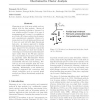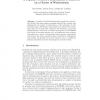2466 search results - page 156 / 494 » Concurrent Clustered Programming |
PPOPP
2006
ACM
14 years 4 months ago
2006
ACM
Applications need to become more concurrent to take advantage of the increased computational power provided by chip level multiprocessing. Programmers have traditionally managed t...
ICML
2006
IEEE
14 years 11 months ago
2006
IEEE
Clustering is one of the most widely used statistical tools for data analysis. Among all existing clustering techniques, k-means is a very popular method because of its ease of pr...
BIOINFORMATICS
2004
13 years 10 months ago
2004
Motivation: The gene expression intensity information conveyed by (EST) Expressed Sequence Tag data can be used to infer important cDNA library properties, such as gene number and...
ICCSA
2004
Springer
14 years 3 months ago
2004
Springer
Abstract. A number of individual bioinformatics applications (particularly BLAST and other sequence searching methods) have recently been implemented over clusters of workstations ...
EMSOFT
2009
Springer
14 years 4 months ago
2009
Springer
Concurrent programming languages are growing in importance with the advent of multi-core systems. However, concurrent programs suffer from problems, such as data races and deadloc...



